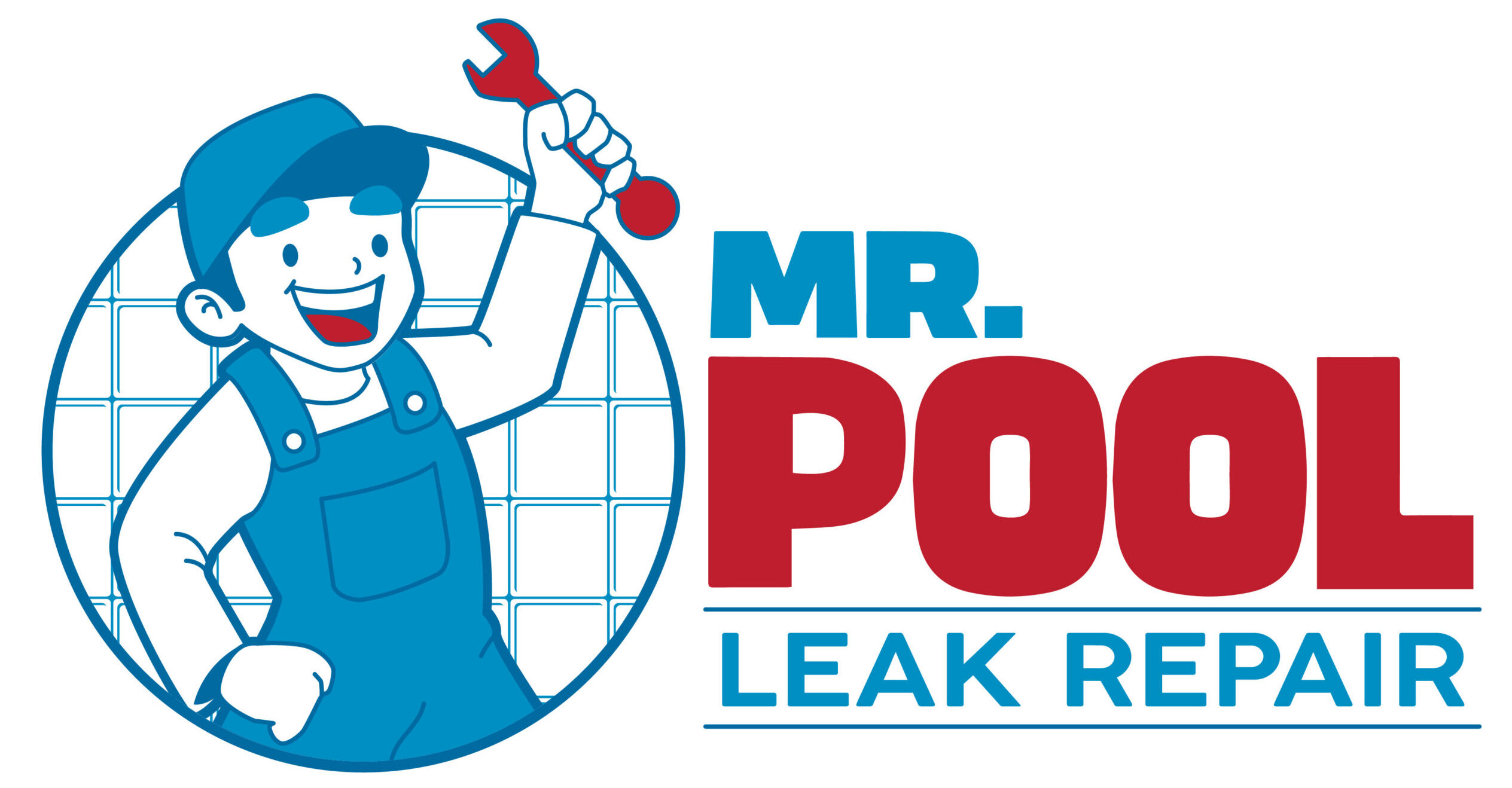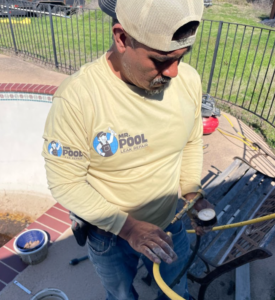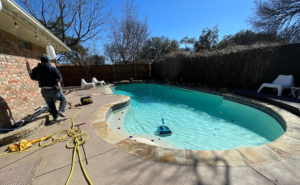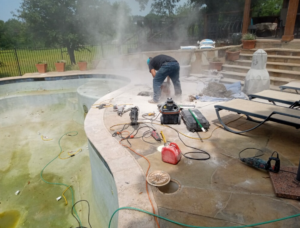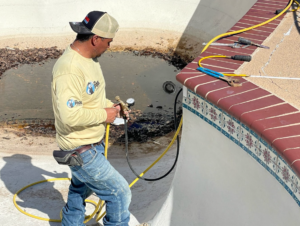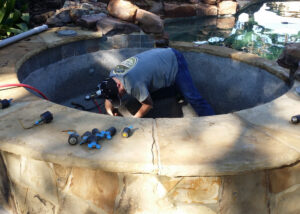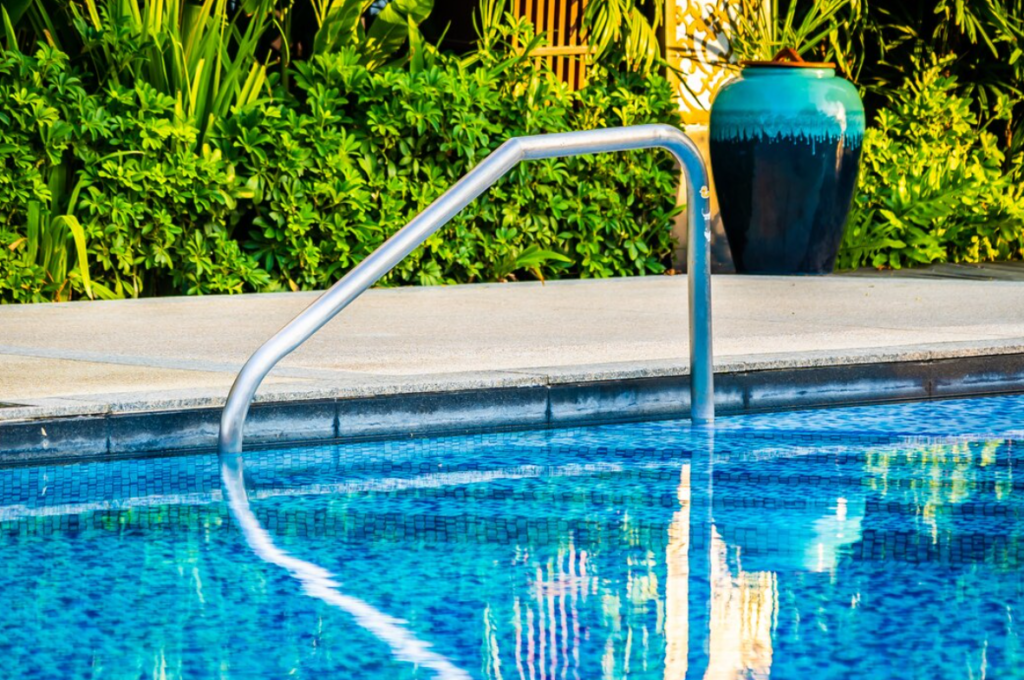
Swimming pool leak detection is an essential aspect of pool maintenance. Leaks in your pool can occur at various locations and can be challenging to identify. Before you initiate the process of swimming pool leak detection, it’s crucial to eliminate other potential issues, such as evaporation or a crack in your filter system plumbing. This guide is designed to assist you in identifying and rectifying a leak in your pool. Keep reading to acquire the knowledge and techniques necessary for effective swimming pool leak detection and repair.
How can you tell where your pool is leaking?
You’ll want to check your pool’s plumbing and pool equipment before you start any testing. Check the entire filter system. This includes your pool filter, heater and chlorinator as well as any O-rings or connections that may be leaking water. These leaks are relatively easy to fix.
There’s still a possibility that there is a leak somewhere in your plumbing system you cannot see. If you have an underground swimming pool, a leak can occur in the piping. Even if there is no plumbing leak, it’s important to check your pool first to ensure that water is not being lost to evaporation.
Is Your Pool Evaporating or Leaking?
To detect a pool leak, you must first determine whether water is being lost due to evaporation. You’ll then narrow down the source. This can be done with either the Ink Test or the Bucket Test.
Pool Leak Detection: Bucket Test
You probably already have the materials you need to complete this DIY project.
- Plastic bucket 5 gal.
- Waterproof marker or Duct Tape
- Place the bucket and fill it. Place your 5-gallon empty bucket on the second step in your pool. Fill the bucket to the same level as the water in the pool. Mark this level with duct tape or a marker.
- Turn off the pump. Turn off any auto-refill devices you may have, including the recirculating pumps.
- Compare water levels. Compare the water levels in the bucket and the pool after 24 hours. Both the pool water and the water in the bucket have decreased but are still the same, then your pool is losing its water through evaporation. If the bucket level is lower than the pool level, then you have a leak.
- Repeat the test with pump on. Repeat the test again for another 24 hours, but this time turn on the pump.
- Compare the results. The leak in your pool will be more obvious if the water loss is higher when the water is under pressure.
Pool Leak Detection: Dye Test
This method is a bit more complicated, but will allow you to pinpoint the exact location of a leak. Purchase a leak-finder dye that you can add to the pool water. You should also have waterproof tape handy for marking any leaks in your pool.
- Check the Walls and Ground Around the Pool. If you see water on the ground where it should not be, then your pool may have a leak in that area. Continue to narrow it down before you use the leak-finder dye.
- Shut off the water pump and all other features. The water should be as still and as clear as possible when using the dye. You can also use this to detect leaks near or in the skimmer.
- You can use the pool leak detection dye to pinpoint the leak. You can use the pool leak detection dye to pinpoint the exact location of the leak. Squirt dye into the water near the surface of the pool and the wall without touching it. You will notice that the dye moves towards the location of the leak as if it were a current.
- Mark the spot for patching. Mark the area with waterproof tape where the dye that detects leaks is moving. You can use this to remember where to patch up the leak.
You’ll need to wear goggles to do the test if you suspect the leak is in the pool bottom if you want to remain as still as you can when running the test so that the dye does not spread.
You’ll need to repair plaster if you have a concrete or gunite swimming pool that has developed cracks. This is especially true where the plastic skimmer joins the pool wall. You can find a complete guide on how to repair plaster in a pool. If your pool is lined with vinyl, you can fix the patch by yourself.
How to Fix a Leak on Your Vinyl Pool Liner
A vinyl-lined pool is easy to repair leaks. A quality patch that is placed correctly can last many years. No matter how you repair the pool liner, all patches are temporary. The bigger the tear, the greater the likelihood that it will peel or snag over time.
Before you attempt any repairs, determine if the liner is worth patching or if it is time to replace it. The thinner the liner becomes with age, the more likely it is that it will spring leaks.
Keep in mind that the water from your pool will pull any area near the stairs and the fittings of your pool. These areas are more stressed than others, and so may not last as long.
You can choose between three different methods for repairing the leak. All of them are suitable to be used either underwater or on dry land. Draining your pool is not the best way to repair a leak. It shouldn’t be necessary to drain your pool to patch a leak. Too much water can collapse the walls of an above-ground pool. Emptying out a pool that has a vinyl liner can cause the liner to become brittle. Plan to repair the liner below the waterline unless there is a leak that is dry and above it.
1. Waterproof Tape
This tape is similar to ducttape, but it’s clear, waterproof and resistant to UV radiation. This tape can be overlapping if you want to repair large areas. This is the cheapest option, and it’s also the easiest to fix if you make an error. It’s better for small leaks, as it peels over time.
2. Peel-and Stick Patches
These patches are made from real vinyl and specifically designed for pools. Some patches have been pre-cut in round shapes to reduce the likelihood of them peeling around the edges. These patches are also easy to use and inexpensive: just remove the backing, and press on the leak. They’re best for smaller holes or tears.
3. Vinyl Patch Kit
Use a vinyl patch kit if you need to fix a large hole or want a long-lasting solution. These kits include large pieces of clear or blue liner, as well as a special underwater vinyl adhesive. They are more difficult to use, but will last longer than waterproof adhesive or peel-and stick patches.
You should always ask a professional to test and repair a pool leak.
The cost of pool leak detection services can be several hundred dollars. While some pool companies may include minor repairs in their price, it is worth trying these methods first before hiring a professional.
If you have an inground swimming pool and suspect that the leak may be underground, you will need to hire a professional pool technician to perform a pressure test to check for cracks.
If you find that swimming pool leak detection, or any other pool repairs, are too difficult to do, or if you’re not certain you’re getting good results, you should consult a professional.
REMODELLING SERVICES
We are doing your Leak detection,
these are the other services we provide
- Spray Deck
- Demo Concrete
- Deco Seal
- Plaster
- Tile Design
- Repair Pavers
